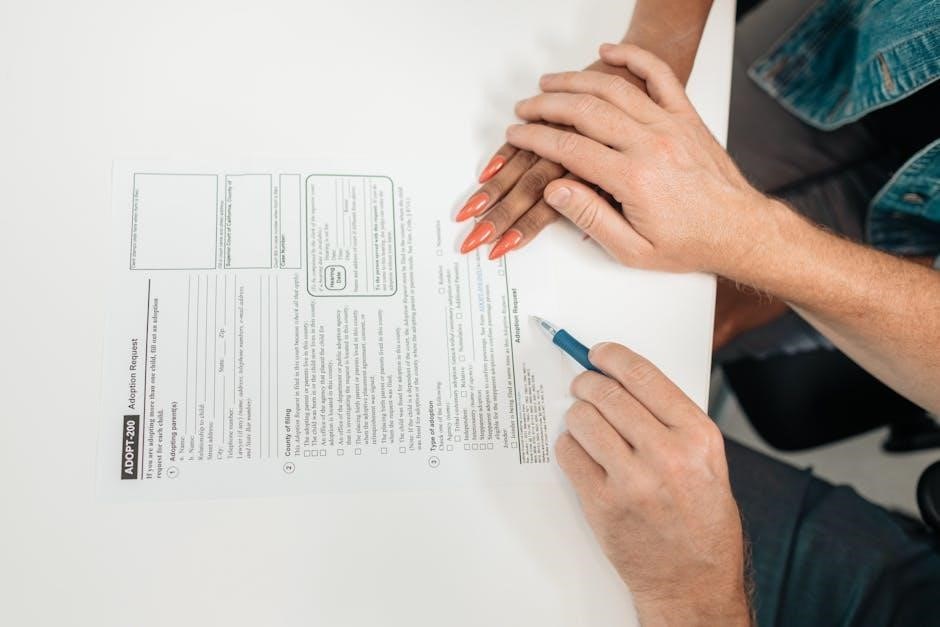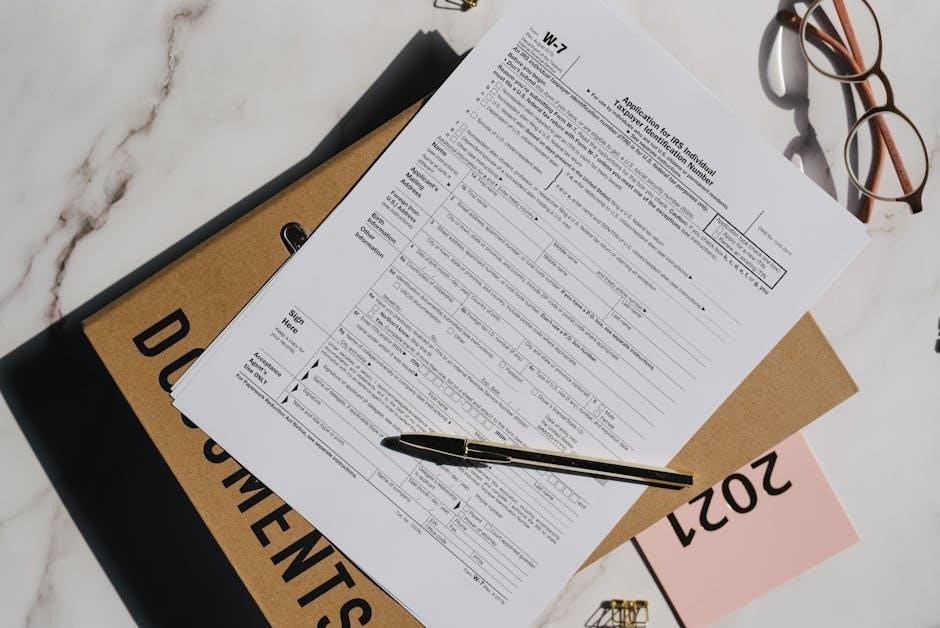The ADP Application Form is a critical document for Ontario residents seeking financial assistance for assistive devices. It streamlines the process of requesting funding‚ ensuring accessibility and equity for individuals with disabilities. The form has been enhanced with electronic signature capabilities and simplified submission methods‚ making it more user-friendly. Case managers play a vital role in guiding applicants through the process‚ ensuring fair and consistent determinations for all. This form is essential for obtaining necessary devices‚ promoting independence and improving quality of life.
1.1 Overview of the Assistive Devices Program (ADP)
The Assistive Devices Program (ADP) is a government-funded initiative in Ontario designed to help individuals with disabilities access essential assistive devices. It provides financial support for a wide range of devices‚ including mobility aids‚ communication devices‚ and respiratory equipment. The program aims to enhance independence‚ quality of life‚ and participation in daily activities. Eligibility is determined based on medical need and financial requirements‚ with applications typically requiring input from healthcare professionals. The ADP ensures equitable access to necessary tools‚ fostering inclusivity and improving overall well-being for Ontarians with disabilities.
1.2 Importance of the ADP Application Form
The ADP Application Form is crucial for individuals seeking financial assistance for assistive devices in Ontario. It serves as the primary gateway to accessing funding‚ ensuring that applicants can request necessary support efficiently. The form streamlines the evaluation process‚ enabling case managers to make fair and consistent determinations. Its structured format ensures all required information is collected‚ reducing delays and misunderstandings. By completing the form accurately‚ applicants can demonstrate their eligibility and medical needs‚ ultimately gaining access to life-enhancing devices. Its importance lies in its role as a tool for improving accessibility and quality of life for Ontarians with disabilities.

Eligibility Criteria for ADP
The ADP is designed for Ontario residents with permanent physical disabilities requiring assistive devices. Eligibility is based on medical need‚ income level‚ and device requirements‚ ensuring fair access to necessary support.
2.1 Who Can Apply for ADP in Ontario?
The ADP is available to Ontario residents with permanent physical disabilities requiring assistive devices. Applicants must demonstrate a medical need for devices to enhance mobility‚ communication‚ or daily living. Eligibility is not solely based on income but on the necessity of the device. Individuals must be Ontario residents and have a valid health card. The program prioritizes those with long-term disabilities‚ ensuring equitable access to essential tools for independence. Case managers assist in determining eligibility and guiding applicants through the process.
2.2 Income and Disability Requirements
To qualify for ADP‚ applicants must meet specific income and disability criteria. While income is considered‚ it is not the sole determining factor; the program emphasizes medical necessity. A permanent physical disability requiring assistive devices is essential for eligibility. Applicants must provide medical documentation confirming their disability and the need for specific devices. Income thresholds may influence funding levels‚ but the program aims to support all eligible individuals. The focus is on enabling independence and improving quality of life through necessary assistive technologies‚ ensuring equitable access regardless of financial status.
2.3 Types of Assistive Devices Covered
The ADP covers a wide range of assistive devices to support individuals with disabilities. This includes communication aids‚ mobility equipment like wheelchairs and walkers‚ and home modifications for accessibility. Devices must be prescribed by a healthcare professional and deemed medically necessary. The program also covers certain prosthetic and orthotic devices‚ as well as sensory aids for hearing or vision impairments. The list of eligible devices is regularly updated to reflect advancements in technology and patient needs. Detailed eligibility criteria and covered items are outlined in the official ADP application form and guidelines.

Required Documents for ADP Application
The ADP application requires identification‚ proof of residency‚ medical documentation‚ and income verification. These documents ensure eligibility and facilitate a smooth review process for applicants.
3.1 Identification and Proof of Residency
Applicants must provide valid government-issued ID and proof of Ontario residency. Acceptable documents include a driver’s license‚ passport‚ or utility bills. Ensure all documents are current and legible. Name changes require additional documentation‚ such as a marriage certificate. These verifications are crucial for processing the ADP application efficiently. Proper identification ensures eligibility and residency confirmation‚ streamlining the review process. Submitting clear and valid documents helps avoid delays. Always check expiration dates and ensure accuracy to facilitate a smooth application experience.
3.2 Medical Documentation and Assessments
Detailed medical documentation is essential to support your ADP application. You must provide assessments from authorized healthcare professionals‚ such as physicians or occupational therapists. These documents should outline your specific disability and the necessity for the assistive device. Ensure all medical records are current and clearly state how the device will improve your daily life. Electronic signatures are now accepted for medical forms‚ simplifying submission. Accurate and relevant documentation is crucial for a smooth review process. Always verify the validity and relevance of your medical records before submitting your application.
3.3 Income Verification and Financial Information
Applicants must provide detailed income verification to determine eligibility and funding levels. Required documents include recent tax returns‚ pay stubs‚ or Social Assistance benefit statements. Retirement or pension statements may also be needed. Ensure all financial information is accurate and up-to-date‚ as discrepancies can delay processing. Electronic submission now allows for easier verification. Case managers can assist in gathering and reviewing financial documents. Proof of residency‚ such as utility bills‚ may also be required. Incomplete or inaccurate financial information can result in extended processing times or application denial.

Completing the ADP Application Form
Complete the ADP Application Form accurately to ensure timely processing. The form includes sections for personal‚ medical‚ and financial details. Use the new electronic signature feature for convenience. Ensure all required fields are filled and attachments are included. Consult with a designated therapist or case manager for assistance. Proper completion avoids delays and ensures eligibility assessment is straightforward. Review the form thoroughly before submission to confirm all information is accurate and up-to-date.
4.1 Understanding the Structure of the Form
The ADP Application Form is organized into clear sections‚ making it easier to navigate. It begins with personal and contact information‚ followed by medical details and required documentation. The form includes sections for income verification‚ device specifications‚ and consent for information sharing. Electronic signatures are now accepted‚ streamlining the process. Each section is designed to gather specific information‚ ensuring eligibility and funding decisions are made accurately. Understanding the structure helps applicants provide complete and accurate information‚ reducing delays in processing.
4.2 Step-by-Step Guide to Filling Out the Form
Begin with personal and contact information‚ ensuring accuracy. Next‚ complete the medical details section with input from your healthcare provider. Attach required documents‚ such as proof of income and medical assessments. Review the device specifications to ensure they meet your needs. Sign and date the form‚ taking advantage of the electronic signature option for convenience. Double-check all sections for completeness and accuracy before submission. This step-by-step approach ensures a smooth and efficient application process‚ minimizing delays and ensuring eligibility is properly assessed.
4.3 Tips for Avoiding Common Mistakes
Read the instructions carefully before starting the form. Ensure all sections are fully completed‚ paying attention to required fields. Use electronic signatures to avoid delays. Double-check personal and medical information for accuracy. Attach all necessary documents‚ such as proof of income and medical assessments. Avoid submitting incomplete applications‚ as this can lead to extended processing times. Seek assistance from a healthcare provider or caseworker if needed. Review the form thoroughly before submission to ensure no errors or omissions. This helps prevent delays and ensures a smooth application process.

Submission Methods for the ADP Application
The ADP application can be submitted online‚ in person at designated centers‚ or by mail. Each method ensures convenient and secure processing of your request.
5.1 Online Submission Process
The ADP application form now supports electronic signatures and eSubmission‚ making the process efficient and streamlined. Applicants can upload required documents directly‚ reducing processing times and paperwork; This method is environmentally friendly and ensures timely submission. Before finalizing‚ verify all information for accuracy to avoid delays. The online portal is secure and user-friendly‚ guiding applicants through each step. Once submitted‚ a confirmation email is sent‚ providing peace of mind. For detailed instructions‚ visit the official Ontario government website.
5.2 In-Person Submission at Designated Centers
In-person submission is a convenient option for applicants preferring face-to-face assistance. Visit a designated ADP center with a completed application and required documents. Trained staff are available to guide you through the process‚ ensuring accuracy. Bring all necessary paperwork‚ including identification and medical documents. This method allows for immediate submission confirmation‚ reducing wait times. Centers are equipped to assist with scanning or photocopying‚ making the process seamless. Appointments may be recommended to avoid delays. This option is ideal for those needing hands-on support or without access to digital tools.
5.3 Mailing the Application Form
Mailing your ADP application is a reliable method for submission. Ensure all required documents are included and securely packaged. Use certified mail with a tracking number to monitor delivery. Address the envelope to the designated ADP office listed on the form. Double-check the mailing address to avoid delays. Include a cover letter with your contact information for follow-up. Properly organizing your application reduces processing time. Verify that all sections are complete and signed before mailing. This method is ideal for those who prefer traditional submission or lack access to digital tools.

Processing Time and Follow-Up
The ADP application typically takes 2-6 months to process. Applicants can track their status online or by contacting ADP support. Delays may occur if forms are incomplete.
6.1 Average Processing Time for ADP Applications
The average processing time for ADP applications is typically 2 to 6 months. Delays may occur due to incomplete submissions or high volumes of requests. Applicants are advised to ensure all required documents are included to avoid extended wait times. Processing times may vary depending on the complexity of the application and the workload of the review team. Submitting applications online or through designated centers can sometimes expedite the process. It’s important to follow up with ADP support if the expected timeframe exceeds six months.
6.2 How to Track the Status of Your Application
To track the status of your ADP application‚ visit the official Ontario government portal or contact ADP support directly. Applicants can log in to their online account using their reference number to check real-time updates. For phone inquiries‚ call the ADP hotline and provide your application reference number for assistance. Additionally‚ applicants can email the ADP support team with their inquiry. Ensure to keep your reference number handy for faster processing. Tracking helps applicants stay informed and address any issues promptly‚ ensuring a smoother experience.
6.3 What to Do If Your Application is Delayed
If your ADP application is delayed‚ contact ADP support immediately. Provide your reference number for faster assistance. Check if your application was submitted correctly and ensure all required documents were included. Follow up regularly for updates and clarify any issues promptly. Delayed applications often result from incomplete submissions‚ so verifying the accuracy of your paperwork is essential. Addressing delays early helps resolve issues quickly and ensures you receive the assistive devices you need without further wait. Proactive communication with ADP support can help expedite the process and prevent extended waiting periods.

Denial of ADP Application
An ADP application may be denied if it lacks required documents or fails to meet eligibility criteria. Applicants should review the denial letter‚ address issues‚ and resubmit if necessary. Understanding the reasons for denial is crucial for revising and reapplying effectively. Ensuring all information is accurate and complete can help avoid future denials and improve the chances of approval. Addressing gaps in the application is essential for securing the necessary assistive devices. Proper documentation and clear communication with ADP support can facilitate a successful appeal or reapplication process.
7.1 Reasons for Application Denial
An ADP application may be denied due to incomplete or inaccurate information‚ missing documentation‚ or failure to meet eligibility criteria such as income thresholds or disability requirements. Additionally‚ the requested device may not be covered under the program or may not be deemed medically necessary. Applicants must carefully review the denial letter to identify specific reasons and address them. Resubmitting with corrected or additional information‚ such as updated medical assessments or financial documentation‚ can help resolve issues. Understanding the denial reasons is crucial for revising and resubmitting the application effectively.
7.2 How to Appeal a Denied Application
If your ADP application is denied‚ you can appeal the decision by following specific steps. First‚ review the denial letter to understand the reasons for rejection. Gather any additional documentation or evidence to address these reasons‚ such as updated medical assessments or proof of income. Submit a written appeal request within the specified deadline‚ typically 30 days‚ to the designated office. Include the completed appeal form and supporting documents. You may also seek assistance from case managers or community organizations. The appeal will be reviewed‚ and you will receive a final decision. Understanding the process ensures a stronger case for reconsideration.
7.3 Understanding the Appeal Process
The appeal process for a denied ADP application involves a structured review of the decision; Applicants must submit a formal appeal within 30 days of receiving the denial letter. This includes a written request and any new or additional evidence to support reconsideration. The appeal is reviewed by an independent panel to ensure fairness and consistency. Understanding the process is crucial for preparing a strong case. Seek guidance from case managers or legal advisors to navigate the requirements effectively. Timely and thorough preparation increases the likelihood of a successful outcome.

Approved Applications and Next Steps
Once approved‚ applicants receive funding for designated assistive devices. They can access devices through authorized vendors and must complete any required follow-up or renewal processes to maintain support.
8.1 What Happens After Approval
Once approved‚ applicants receive notification and guidance on obtaining funded devices. They can purchase equipment from authorized vendors‚ with ADP covering a portion of costs. Some applicants may receive direct funding. Case managers ensure smooth transitions‚ addressing any post-approval queries. Recipients must adhere to program guidelines‚ including proper device usage and maintenance. Follow-up assessments may be required to ensure ongoing eligibility. Renewals are necessary for continued support‚ typically involving updated medical documentation. The process is designed to maintain accessibility and independence for individuals with disabilities‚ ensuring they receive necessary assistance without interruption.
8.2 How to Access Funded Devices
After approval‚ applicants can access funded devices through authorized vendors registered with ADP. They must select devices from approved suppliers and provide documentation of purchase. ADP reimburses a portion of the cost‚ with the client paying the remaining balance. Case managers assist in identifying suitable vendors and understanding pricing. Once purchased‚ recipients must submit proof of acquisition for reimbursement. Devices are monitored for proper usage‚ ensuring they meet the individual’s needs. Renewal of funding requires periodic reassessment of eligibility and device functionality. This process ensures continuous support and accessibility for individuals with disabilities.
8.3 Ongoing Requirements and Renewals
Approved applicants must meet ongoing requirements to maintain funding eligibility. Periodic reassessments ensure continued need for assistive devices. Updated medical documentation may be requested to verify ongoing eligibility. Device usage is monitored to ensure proper functionality and alignment with initial approval criteria. Renewal applications must be submitted as required‚ typically every five years or as specified. Failure to comply with renewal processes may result in discontinued funding. Applicants are encouraged to stay informed about program updates and maintain communication with ADP case managers to ensure uninterrupted support. Timely renewals are crucial for sustained access to essential assistive devices.

Additional Resources and Support
Official guides‚ tutorials‚ and support services are available to assist with ADP applications. Community organizations and expert consultations provide additional help‚ ensuring applicants navigate the process smoothly and effectively.
9.1 Contact Information for ADP Support
For assistance with the ADP application‚ contact the program directly at adp@ontario.ca or call 1-800-268-6021. Additional support is available through local community organizations and case managers‚ who can guide applicants through the process. The Ontario Ministry of Health website also provides detailed resources and contact information for further inquiries. Applicants can access help through various channels‚ ensuring they receive the support needed to complete their applications effectively and efficiently.
9.2 Community Organizations Assisting with ADP Applications
Community organizations play a vital role in assisting individuals with ADP applications. Groups like the Ontario Federation for Cerebral Palsy and March of Dimes Canada offer workshops‚ one-on-one support‚ and guidance to help applicants navigate the process. Local non-profits often provide resources‚ such as form completion assistance and advocacy. These organizations ensure that individuals‚ especially those with limited access to resources‚ can successfully apply for the program. Their support is invaluable in making the ADP application process more accessible and user-friendly for all eligible Ontarians.
9.3 Online Guides and Tutorials
Online guides and tutorials provide comprehensive support for completing the ADP application form. The Ontario government offers step-by-step video tutorials and downloadable PDF guides to help applicants understand eligibility criteria and required documents. These resources are accessible on the official ADP website‚ ensuring applicants can navigate the process independently. Additionally‚ interactive tools like application checklists and FAQ sections are available to address common concerns. These online resources are designed to simplify the application process‚ making it more accessible and less intimidating for individuals with disabilities and their caregivers.

Frequently Asked Questions (FAQs)
Common questions include eligibility criteria‚ required documents‚ and submission methods. Applicants often inquire about processing times‚ approval steps‚ and how to track their application status online.
10.1 Common Queries About the ADP Application
Applicants often inquire about eligibility criteria‚ required documents‚ and submission methods. Common questions include how to track application status‚ processing timelines‚ and troubleshooting submission issues. Many ask about the types of assistive devices covered and income requirements. Others seek clarity on how to appeal denied applications or understand the electronic signature process. Additionally‚ queries about renewals‚ application deadlines‚ and necessary medical documentation are frequent. These questions highlight the need for clear guidance to navigate the ADP application process effectively.
10.2 Clarifications on Eligibility and Documentation
Clarifications often focus on eligibility criteria‚ such as income thresholds and disability requirements. Applicants seek details on acceptable medical documentation‚ like assessments from approved therapists. Questions arise about proof of Ontario residency and how income is verified. There is also confusion about the types of devices covered and the documentation needed to justify their necessity. Additionally‚ applicants inquire about how to demonstrate a permanent disability and the role of case managers in verifying eligibility. These clarifications ensure applicants understand what is required for a successful submission.
10.3 Troubleshooting Submission Issues
Common submission issues include incomplete forms‚ incorrect information‚ or technical problems with online applications. Applicants often struggle with uploading documents or receiving confirmation emails. Issues may also arise from missing signatures or outdated browser versions. To resolve these‚ check the help page for solutions‚ contact ADP support‚ or consult the FAQ section. Ensuring all required fields are filled and documents are properly formatted can prevent delays. If issues persist‚ seeking assistance from a case manager or support organization is recommended to ensure a smooth application process.
The ADP application process is designed to provide essential support for individuals with disabilities. Accurate and complete submissions ensure timely approvals and access to necessary assistive devices‚ enhancing independence and quality of life.
11.1 Summary of the ADP Application Process
The ADP application process involves submitting a completed form with required documents‚ such as medical assessments and income verification. Eligibility is determined based on disability and financial need. Applicants can submit online‚ in-person‚ or by mail. Processing times vary‚ but accurate submissions ensure faster approvals. Denials can be appealed‚ and approved applications provide access to funded devices. Ongoing requirements include renewals and maintaining eligibility. The process is designed to support independence and improve quality of life for individuals with disabilities in Ontario.
11.2 Importance of Accurate and Complete Applications
Submitting an accurate and complete ADP application is crucial for ensuring timely processing and approval. Incomplete or incorrect information can lead to delays or denials‚ requiring additional steps to resolve. Proper documentation‚ such as medical assessments and financial details‚ ensures eligibility is clearly established. Double-checking all sections and adhering to submission guidelines helps avoid common pitfalls. Accuracy also minimizes the need for follow-up‚ allowing applicants to access necessary assistive devices without unnecessary wait times. A well-prepared application demonstrates responsibility and respect for the program’s requirements‚ fostering a smoother experience for all parties involved.
11.3 Final Tips for a Smooth Application Experience
To ensure a seamless ADP application process‚ start early and thoroughly review all requirements. Seek assistance from case managers or support organizations if needed. Double-check all sections for accuracy and completeness before submission. Utilize online resources and guides for clarity. Submitting applications electronically can expedite processing. Keep copies of all documents for your records. Following these steps minimizes delays and ensures you receive the necessary assistive devices promptly. Preparation and attention to detail are key to a hassle-free experience.
